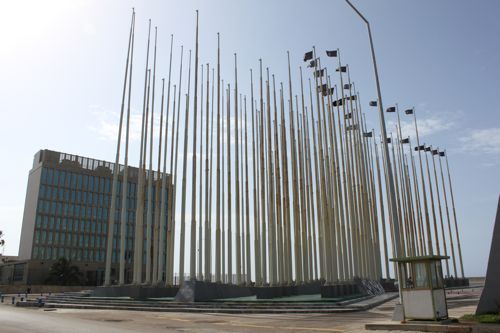American diplomats work out of a five-story building that rises above a famed seaside walkway known as the Malecon. Before the 1959 revolution, the building was the U.S. embassy. But since the United States and Cuba do not have diplomatic relations today, it now goes by another name: the U.S. Interests Section. And Cuban officials regard it with suspicion. From this waterfront headquarters, they contend, U.S. officials are plotting ways to force Fidel Castro and his brother Raul from power.
American officials say there's nothing subversive going on. They say they're only trying to help Cubans improve their lives, enjoy greater basic freedoms and "hasten the transition to democracy."
Toward that end, U.S. taxpayers have spent hundreds of millions of dollars over the past several decades.The State Department provides a snapshot of the recent spending:
2007 - $13.3 million.
2008 - $45.33 million.
2009 - $20 million.
2010 - $15 million granted, $5 million pending.
2011 - $20 million requested.
The total: $113 million, a conservative estimate that doesn't take into account other Cuba programs run by the CIA, Department of Defense, Department of Treasury, Department of Homeland Security, Coast Guard and other agencies.
A State Department document reads:
"Cuba is the only non-democratically elected government in the Western Hemisphere, and one of the most politically repressed countries in the world. In view of these challenges, U.S. assistance for Cuba aims to empower Cuban civil society to advocate for greater democratic freedoms and respect for human dignity."
So is U.S. aid to Cuba helping to build a democracy? Has the more than $100 million in State Department funds had an impact?
Odalys Zurma Gonzalez, 45, isn't sure where all the money has gone, but she is grateful that the U.S. is supporting Cuba's dissident movement. She said she is an independent journalist and learned to write stories and gather information while taking a five-month-long journalism course at the Interests Section in 2009.
"They had very good teachers," she said, adding that the course was free.
Gonzalez said she does not receive a salary from the U.S. government.
"We're not paid, nor are we mercenaries, nor are we on the payroll of a foreign government," she said.
Gonzalez is a member of Las Damas de Apoyo, a support group for Las Damas de Blanco, or Ladies in White.
Las Damas de Blanco is made up mostly of wives and other relatives of 75 dissidents, journalists, human rights activists jailed during a crackdown in March 2003. Since then, the group has marched on Sundays in Havana to demand the release of their loved ones.
Gonzalez said she joined Las Damas de Apoyo to demand political change and freedom for the prisoners.
"I think it's a just cause," she said. "We simply want the government to respect basic human rights."
Cuban officials contend that U.S. government officials and U.S.-funded private contractors have helped finance Las Damas marchers.
"We weren't born yesterday," said a senior Cuban official who spoke on condition of anonymity. "We have been seeing this for 50 years. We know how American officials work now and how they've worked in the past."
Very few of the millions of State Department dollars ever reach Cuba, the official said.
"It's insignificant, really."
Even so, he said, Cuban officials take offense to the U.S. aid programs and try to monitor dissidents who receive funds.
"When an individual receives money or resources form a foreign government that's trying to topple our government, he has become a mercenary. We've said that 1,000 times."
Just the other day, the official said, the U.S. government announced that yet another contract was up for grabs. The bid is worth $3.5 million for a pro-democracy program in Cuba.
"It's a profound lack of respect that one government publishes in this way its intention to overthrow another government and to pay for it," the official said. "What would happen if someone announced a $3.5 million bid to topple the U.S. government? What does the government of the United States expect? It shows absolute despise."
Some Cuban officials say they had hoped that President Barack Obama would have done more by now to push for normalized relations with Cuba and end to the so-called embargo, the most severe and longest lasting economic sanctions ever imposed by the U.S. government.
Obama has taken a less belligerent approach toward Cuba than former President George W. Bush. He ordered new rules allowing Cuban-Americans to travel to Cuba freely, for instance. Under the Bush administration, Cuban-Americans could go the island only once every three years.
Workers at the U.S. Interests Section have also taken down an electronic message board from the top of the building. It had been used to transmit everything from baseball scores to declarations on universal human rights.
The message board infuriated Cubans, who had erected dozens of towering flagpoles to prevent people from seeing it.
After the message board came down, Cuban workers took down many of the flagpoles. But some still remain.
Dissidents who are fighting for basic liberties continue their quest for change. U.S. aid to Cuba continues flow. And the 50-year-long grudge match over Cuba, the fight for hearts and minds on both sides of the Florida Straits, shows no signs of ending anytime soon.



